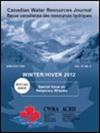气候变化对大型多功能水库迪芬贝克湖热分层的影响
IF 1.7
4区 环境科学与生态学
Q3 WATER RESOURCES
引用次数: 7
摘要
大型多用途水库除具有发电功能外,还具有农业灌溉、畜禽生活用水和防洪等功能。影响水库物理功能和水生生态系统恶化的关键因素之一是气候变化。例如,水温的升高加速了水-沉积物界面的化学反应速率、分解速率和需氧量。热分层发生时间早、储层热分层时间长、强度大都是全球变暖的结果。热分层的这种破坏与低氮离子溶解氧的减少、缺氧事件的增加和储层富营养化的增强有关。在本文中,我们采用二维水动力学和水质模型ce - quality - w2,研究了气候变化和水流情景对加拿大萨斯喀彻温省迪芬贝克湖(Lake Diefenbaker)热结构的影响。模式结果表明,气象变率将决定未来几十年水库水温的非线性上升,其中夏季和秋季上层水温将出现较大的上升。此外,水库流量的减少将降低夏秋两季中间层的水温。该模型可作为缓解和管理气候变化对水库水质影响的工具。本文章由计算机程序翻译,如有差异,请以英文原文为准。
Climate change effects on the thermal stratification of Lake Diefenbaker, a large multi-purpose reservoir
Abstract Large multi-purpose reservoirs serve not only to generate hydropower but to supply water for agricultural irrigation, animal and human consumption and to provide flood control. One of the key factors affecting physical functioning and deteriorating aquatic ecosystems in reservoirs is climate change. For instance, increases in water temperature accelerate chemical reaction rates, decomposition rates and oxygen demand at the water-sediment interface. Earlier thermal stratification onset, and longer and more intense reservoir thermal stratification are all consequences of global warming. Such disruptions in thermal stratification have been associated with reductions in hypolimnion dissolved oxygen, increasing anoxia events and enhancing reservoir eutrophication. In this research paper, we implement the 2 D hydrodynamics and water quality model, CE-QUAL-W2, to investigate the effects of climate change and streamflow scenarios on the thermal structure of Lake Diefenbaker, a large, multipurpose reservoir, located in Saskatchewan, Canada. Model results indicate that meteorological variability will dictate a nonlinear increase in reservoir water temperature in the coming decades, where larger increases in water temperature will occur during summer and fall in the upper layers. Also, decreases in reservoir streamflows will reduce water temperature at intermediate layers during summer and fall. Our model can be used as a tool to mitigate and manage the effects of climate change on the reservoir water quality.
求助全文
通过发布文献求助,成功后即可免费获取论文全文。
去求助
来源期刊

Canadian Water Resources Journal
WATER RESOURCES-
CiteScore
2.90
自引率
5.90%
发文量
17
审稿时长
>12 weeks
期刊介绍:
The Canadian Water Resources Journal accepts manuscripts in English or French and publishes abstracts in both official languages. Preference is given to manuscripts focusing on science and policy aspects of Canadian water management. Specifically, manuscripts should stimulate public awareness and understanding of Canada''s water resources, encourage recognition of the high priority of water as a resource, and provide new or increased knowledge on some aspect of Canada''s water.
The Canadian Water Resources Journal was first published in the fall of 1976 and it has grown in stature to be recognized as a quality and important publication in the water resources field.
 求助内容:
求助内容: 应助结果提醒方式:
应助结果提醒方式:


